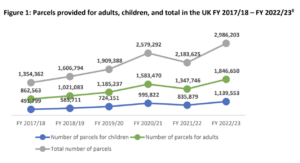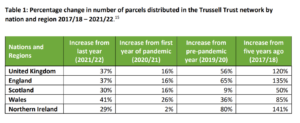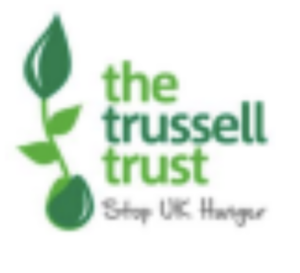Report on: Emergency food parcel distribution in the UK by The Trussell Trust
April 2022 – March 2023
Overview
The Trussell Trust has produced a factsheet reporting on the number of emergency food parcels distributed by food banks in the Trussell Trust network during the period 1 April 2022 to 31 March 2023 inclusive. During this period food banks in the Trussell Trust network distributed parcels from 1,646 locations across the UK.1
It is important to understand that data from food banks in the Trussell Trust network is just one part of the picture of need across the UK. We recognise that there is a wide range of other emergency food provision that will be supporting people that is not captured in this parcel data. Furthermore there are many people who are food insecure who do not receive support from food banks.
8 Key facts from The Trussell Trust 2022/23 statistics report
-
Food banks in the Trussell Trust network have seen the highest levels of need ever, even superseding the peak reached during the pandemic
Food banks in the Trussell Trust network distributed close to 3 million (2,986,203) emergency food parcels between 1 April 2022 to 31st March 2023 (over a million of these parcels were for children). This is the most parcels that the network has ever distributed in a financial year and represents a 37% increase from the same period in 2021/22.

-
Winter was particularly challenging for people, with December the busiest month on record
The number of parcels distributed in December translates to food banks in the Trussell Trust network distributing a food parcel every 8 seconds. Further, this December there has been an 29% increase from December 2021 and a 57% increase from pre-pandemic levels (2019).
-
The November Cost of Living Payment appears to have offered some short-term protection for people on low incomes, however levels of need increased shortly after
This financial year the UK government has provided two Cost of Living Payments to people in receipt of means tested benefits owing to low income in July and November 2022 which resulted in a short-term reduction in need at food banks in the Trussell Trust network.
-
More than 760,000 people used a food bank in the Trussell Trust network for the first time in the last 12 months
Over the last 12 months, more than 328,000 families1 have been forced to turn to food banks in the Trussell Trust network for the first time. This represents a 38% increase in the number of families using a food bank in the network for the first time compared to the same period in 2021/22.2 These families include over 760,000 people.
This is representative of the increasing numbers of people experiencing financial hardship due to the cost of living crisis and supports wider sector research into the impact of the crisis on low-income families. In December 2022, the Joseph Rowntree Foundation (JRF) reported that for all low-income households in the bottom 40% of incomes, 7.2 million (62%) were going without essentials. This means that they had reported going hungry or cutting down the size of meals or skipping meals in the last 30 days or going without basics like showers or adequate clothing since June 2022.3
-
The increase in need for emergency food parcels in 2022/23 in comparison to last year, has been seen across the UK
Looking across England, Northern Ireland, Scotland, and Wales, all areas of the UK experienced an increase in the distribution of emergency food parcels during this financial year (2022/23). Wales experienced the largest percentage increase (41%), followed by England (37%), Scotland (30%) and Northern Ireland (29%).

-
Need is particularly high in certain regions and nations of the UK
Across the UK there has been an increase in the number of parcels distributed since the same period last year; this increase is however more marked in some areas than others such as Wales and the North East of England.
-
Food banks are not just facing a change to operations due to an increase in food parcel distribution, they are also supporting people facing deepening hardship and distress
Food bank staff and volunteers are providing a critical service supporting their communities and have repeatedly adapted their operational practices to meet the level and nature of need for emergency food in their local areas.
-
The majority of the UK public think that food banks should not be needed in the UK
Food banks are stepping in to provide food to people who can’t afford to buy food, and other essentials for themselves. However, food banks are neither the right nor sustainable response to people going without essentials because their incomes are too low.
To read the full report click here
1 At the Trussell Trust we define any household as a family, this means that when we talk about families they could be individuals living alone, single parents, or multi-generational households. 2 In 2021/22 238,146 families were forced to turn to a food bank for the first time, these families included 552,243 people. 3 Going under and without: JRF’s cost of living tracker, winter 2022/23 (2022), Joseph Rowntree Foundation, https://www.jrf.org.uk/report/going-under-and-without-jrfs-cost-living-tracker-winter-202223 15 The data for all regions in England can be found on The Trussell Trust website: https://www.trusselltrust.org/news-and-blog/latest-stats/end-year stats/


